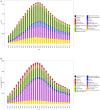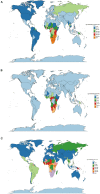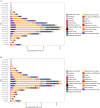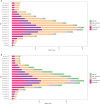Global, regional, and national HIV/AIDS disease burden levels and trends in 1990-2019: A systematic analysis for the global burden of disease 2019 study
- PMID: 36875364
- PMCID: PMC9975742
- DOI: 10.3389/fpubh.2023.1068664
Global, regional, and national HIV/AIDS disease burden levels and trends in 1990-2019: A systematic analysis for the global burden of disease 2019 study
Abstract
Background: Since the first HIV/AIDS case appeared in 1980s, HIV/AIDS has been the focus of international attention. As a major public health problem, there are epidemiological uncertainties about the future of HIV/AIDS. It is important to monitor the global statistics of HIV/AIDS prevalence, deaths, disability adjusted life years (DALYs), and risk factors for adequate prevention and control.
Methods: The Global Burden of Disease Study 2019 database was used to analyze the burden of HIV/AIDS in 1990-2019. By extracting global, regional, and national data on HIV/AIDS prevalence, deaths, and DALYs, we described the distribution by age and sex, explored the risk factors, and analyzed the trends in HIV/AIDS.
Results: In 2019, there were 36.85 million HIV/AIDS cases (95% UI: 35.15-38.86 million), 863.84 thousand deaths (95% UI: 78.61-99.60 thousand), and 47.63 million (95% UI: 42.63-55.65 million) DALYs. The global age-standardized HIV/AIDS prevalence, death, and DALY rates were 454.32 (95% UI: 433.76-478.59), 10.72 (95% UI: 9.70-12.39), and 601.49 (95% UI: 536.16-703.92) per 100,000 cases, respectively. In 2019, the global age-standardized HIV/AIDS prevalence, death, and DALY rates increased by 307.26 (95% UI: 304.45-312.63), 4.34 (95% UI: 3.78-4.90), and 221.91 (95% UI: 204.36-239.47) per 100,000 cases, respectively, compared to 1990. Age-standardized prevalence, death, and DALY rates decreased in high sociodemographic index (SDI) areas. High age-standardized rates were observed in low sociodemographic index areas, while low age-standardized rates were observed in high sociodemographic index areas. In 2019, the high age-standardized prevalence, death, and DALY rates were predominant in Southern Sub-Saharan Africa, and global DALYs peaked in 2004 and subsequently decreased. The highest global HIV/AIDS DALYs were in the 40-44 age group. The main risk factors affecting HIV/AIDS DALY rates included behavioral risks, drug use, partner violence, and unsafe sex.
Conclusions: HIV/AIDS disease burden and risk factors vary by region, sex, and age. As access to health care increases across countries and treatment for HIV/AIDS infection improves, the HIV/AIDS disease burden is concentrated in areas with low SDIs, particularly in South Africa. Regional differences should be fully considered to target optimal prevention strategies and treatment options based on risk factors.
Keywords: HIV/AIDS; burden of disease; deaths; disability-adjusted life years; prevalence; risk factors; trend.
Copyright © 2023 Tian, Chen, Wang, Xie, Zhang, Han, Fu, Yin and Wu.
Conflict of interest statement
The authors declare that the research was conducted in the absence of any commercial or financial relationships that could be construed as a potential conflict of interest.
Figures











References
Publication types
MeSH terms
LinkOut - more resources
Full Text Sources
Research Materials

